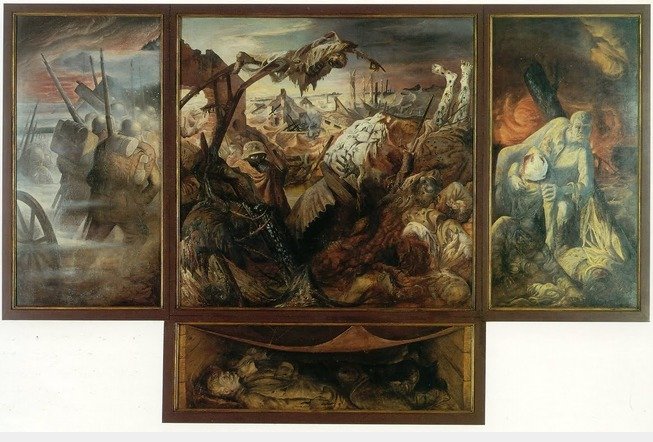War and Peace
In the city of Dresden, there is a painting by a German artist called Otto Dix. He painted it in 1932 to remind people of the unimaginable horror of the First World War. The ‘War Triptych’ carries the image of the dismembered body of a soldier, his flesh scarred and disfigured with bullets, his head sagging under a crown of barbed wire, his broken body slumped amidst the earth and the detritus of the trenches. And yet in one panel of the triptych, there is a man with the artist’s own features, lifting up a wounded comrade. It is a painting which evokes pity and compassion. It compels us to acknowledge the enormity of the sacrifice of those who have fallen in war. And to speak of that painting today perhaps reminds us that when we gather this Sunday to mark the 100th anniversary of Armistice Day, we come not to rejoice at our victories, nor to gloat at the defeat of our enemies. We come to acknowledge the unimaginable horror of war and the costliness of our peace.
The painting evokes strong emotions, but it also draws on the imagery of another painting, the Isenheim altarpiece by Matthias Grunewald. In Grunewald's portrayal of the crucifixion, Christ is depicted suffering almost unimaginable pain, his flesh scarred and disfigured by sores, his head sagging under a crown of thorns. The resonance between these two paintings reminds us that the story of the crucifixion has become one of the archetypes of suffering in Western culture, the image of pain in European art. The image of the cross reminds us, it helps us to remember, that we are not alone, we are not abandoned in our suffering. But in the Christian tradition, the cross speaks not only of our suffering. It also speaks of hope, because it also bears witness to the resurrection of Jesus Christ. The cross and resurrection, which stand at the heart of the Christian mystery, teach us that 'love is stronger than death, passion is fiercer than the grave… Many waters cannot quench love, neither can the floods drown it’ (cf. Song of Songs 8.6-8).
The promise of the resurrection helps us to reimagine peace and a just future for all humanity. This Sunday we will mark Remembrance Sunday at 10.30am at our Choral Eucharist with its Act of Remembrance. At 3.30pm there will also be a Sung Requiem to remember all those who have died in war and conflict and to pray for the peace of the world. The following weekend there will be another opportunity to contemplate these themes. On Saturday 17 November from 7.00pm - 9.00pm, Luxmuralis will stage their remarkable son-et-lumiere in St Mary’s. The title is ‘Imagine Peace’.
God of hope,
be with us through the depths of our despair,
and work in us the costly ways of peace,
that in justice and with gentleness
your will may be done on earth. Amen.
